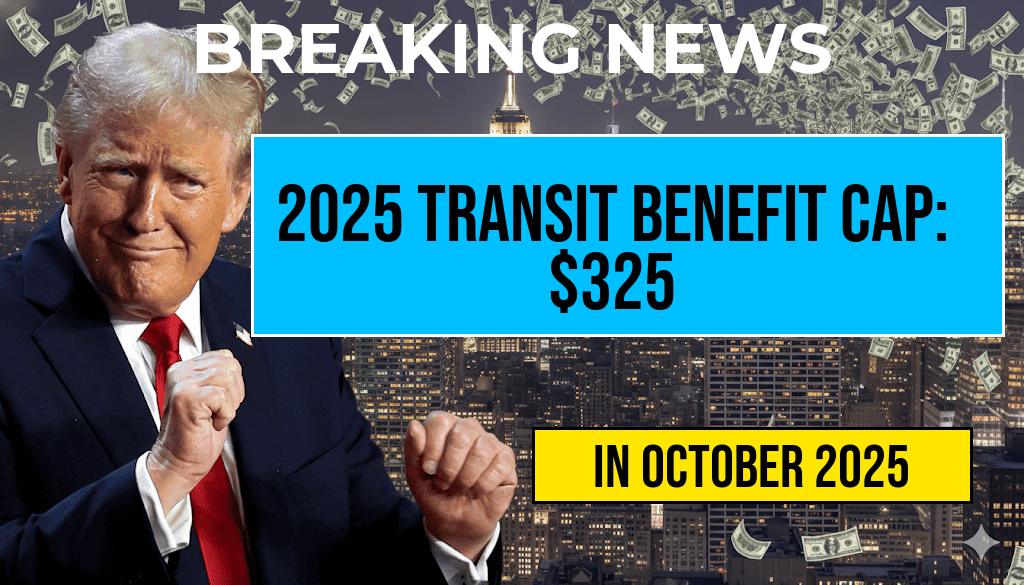The 2025 transit benefit cap has been officially set at $325 per month, marking a significant update for commuters and employers participating in transit benefit programs. This adjustment aims to reflect inflation and rising transportation costs, allowing employees to save more on public transit expenses without tax penalties. As the cap increases from previous levels, many workers and organizations are evaluating how this change will impact their commuting budgets and benefits strategies. Understanding the specifics of this cap, including how it compares to prior years and what it means for tax advantages, is essential for both employees and employers planning their 2025 benefits packages.
Details of the 2025 Transit Benefit Cap
The Internal Revenue Service (IRS) announced that the monthly limit for pre-tax transit benefits will be $325 in 2025. This figure represents an increase from the 2024 cap of $300, adjusting for inflation and economic shifts over the past year. The cap applies to qualified transit expenses, including fares for buses, subways, commuter trains, and vanpooling services. It is designed to encourage the use of public transportation by offering tax advantages for employees who choose environmentally friendly commuting options.
Comparison to Previous Years
| Year | Cap Amount | Change from Previous Year |
|---|---|---|
| 2019 | $265 | N/A |
| 2020 | $270 | $5 |
| 2021 | $280 | $10 |
| 2022 | $285 | $5 |
| 2023 | $300 | $15 |
| 2024 | $300 | No change |
| 2025 | $325 | $25 |
Implications for Employees and Employers
The increased cap offers employees a greater opportunity to save on commuting costs through pre-tax benefits, which reduces taxable income and overall tax liability. For instance, workers who utilize public transit regularly can set aside up to $325 each month without paying federal income or payroll taxes on that amount. This adjustment effectively increases the monthly savings potential by approximately 8.3% compared to the previous year’s limit.
Employers, on the other hand, can leverage this change to enhance their benefits offerings and attract talent seeking flexible, eco-conscious commuting options. Many companies are integrating transit benefits into their overall compensation packages, especially as remote work arrangements evolve and companies seek sustainable benefits that appeal to environmentally aware employees.
Tax Benefits and Limitations
The transit benefit cap relates directly to the IRS section 132(f), which allows employees to pay for transit expenses on a pre-tax basis. Contributions made beyond the $325 limit are considered taxable income, unless the employer offers additional benefits or subsidies. Notably, the cap applies only to transportation expenses and does not include parking benefits, which have their separate limits.
How to Maximize Transit Benefits in 2025
- Plan Ahead: Employees should review their commuting costs early in the year to determine if contributing the maximum amount makes sense, considering their travel frequency.
- Coordinate with Employers: Confirm the company’s benefits program details, including whether they offer direct payroll deductions or pre-tax transit accounts.
- Explore Additional Subsidies: Some employers and local transit authorities provide supplementary subsidies or discounted fare programs that can further reduce commuting costs.
- Stay Informed: Keep track of IRS updates, as benefit caps may be subject to future inflation adjustments or legislative changes.
Broader Transportation Policy Context
The upward adjustment in the transit benefit cap aligns with broader efforts to promote sustainable transportation and reduce carbon emissions. Public transit usage helps cut down on individual vehicle emissions, contributing to environmental goals and urban congestion mitigation. Policies encouraging transit use are increasingly integrated into regional planning initiatives, aiming to create more livable, environmentally responsible communities.
According to data from the Wikipedia entry on public transport in the United States, transit ridership has fluctuated over recent years, with investments in infrastructure and benefits programs playing a role in encouraging more sustainable commuting patterns.
Frequently Asked Questions
What is the new 2025 Transit Benefit Cap?
The 2025 Transit Benefit Cap has been set at $325 per month, allowing eligible employees to receive up to this amount in transit benefits tax-free.
How does the monthly savings work with the new cap?
The cap enables employees to save money on commuting costs by receiving transit benefits up to $325 each month, reducing their taxable income and lowering overall commuting expenses.
Who is eligible for the 2025 Transit Benefit Cap?
Typically, employees participating in employer-sponsored transit benefit programs are eligible, but specific eligibility may vary based on employer policies and local regulations.
Will the Transit Benefit Cap affect my current transit subsidy?
If your current transit subsidy exceeds the $325 cap, it may be adjusted accordingly. Employers will need to ensure benefits are within the new limit to maximize tax advantages.
When does the 2025 Transit Benefit Cap take effect?
The cap is effective starting in 2025, giving employers and employees time to adjust their transit benefit strategies and plan for the upcoming year.






